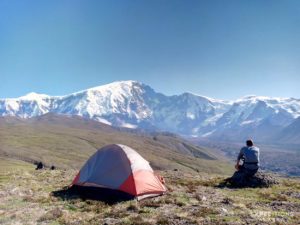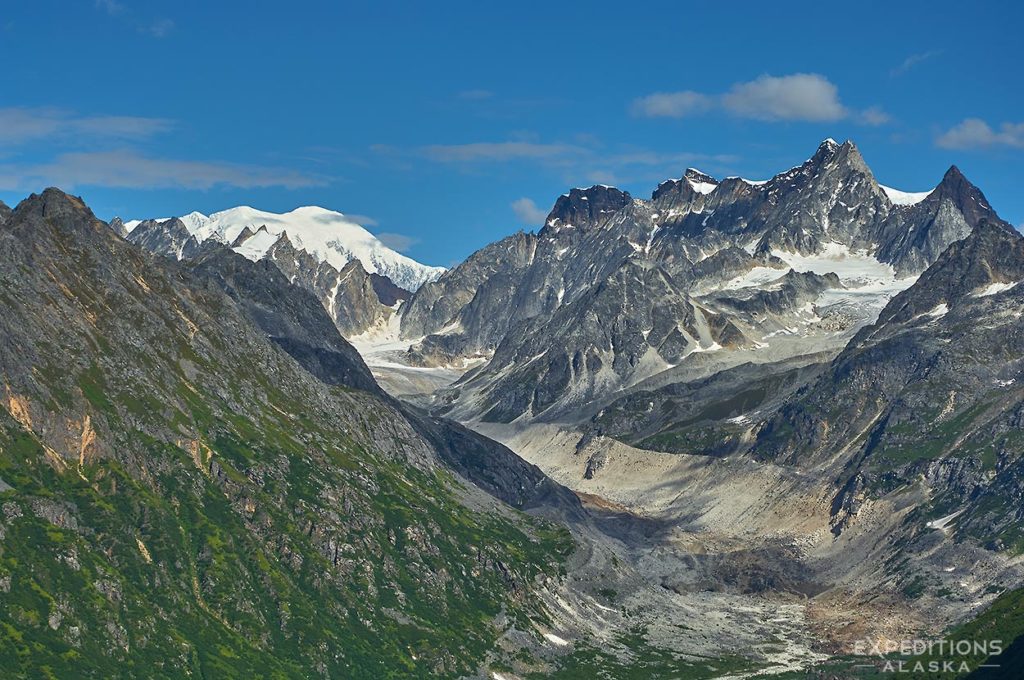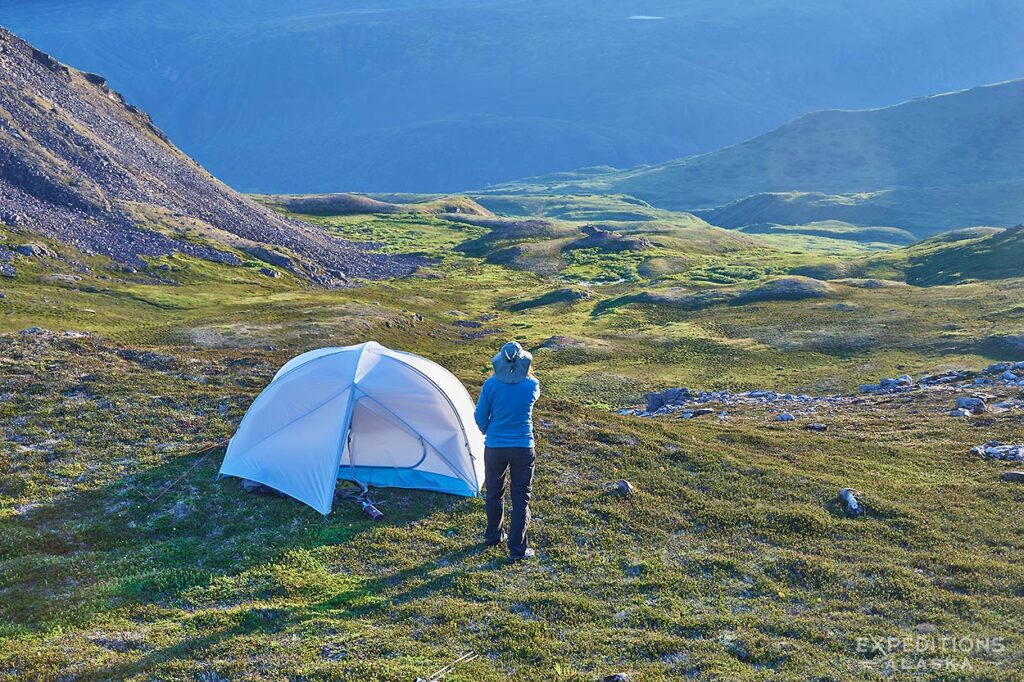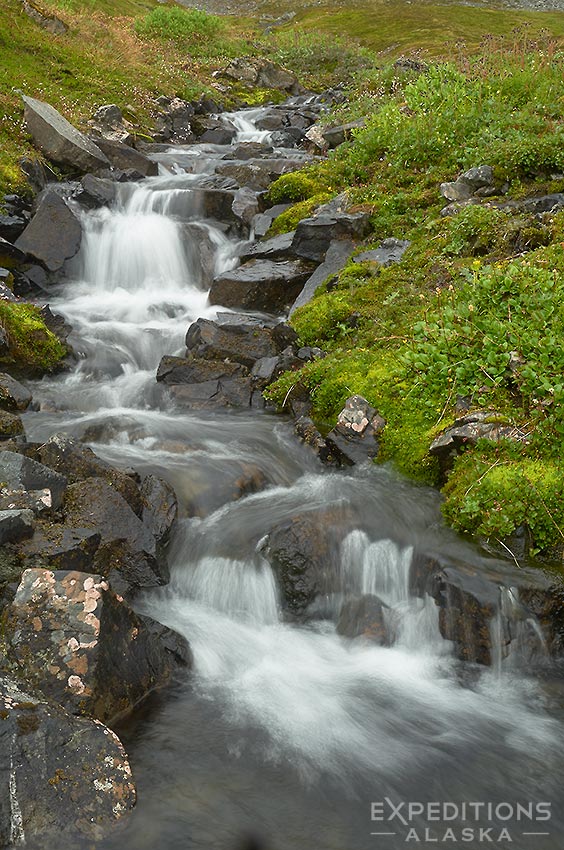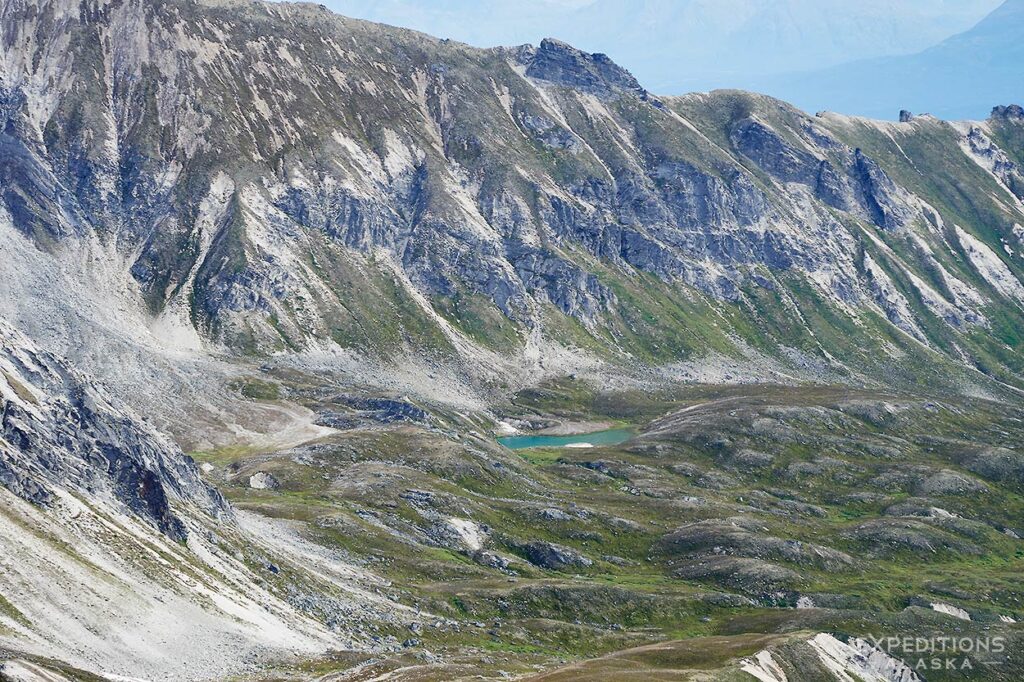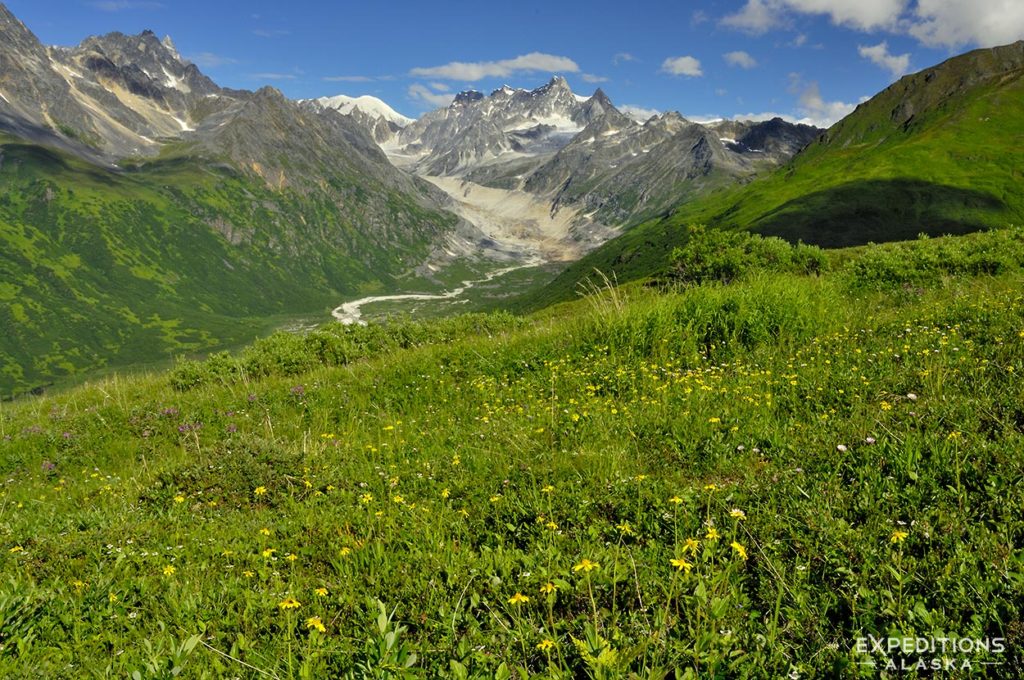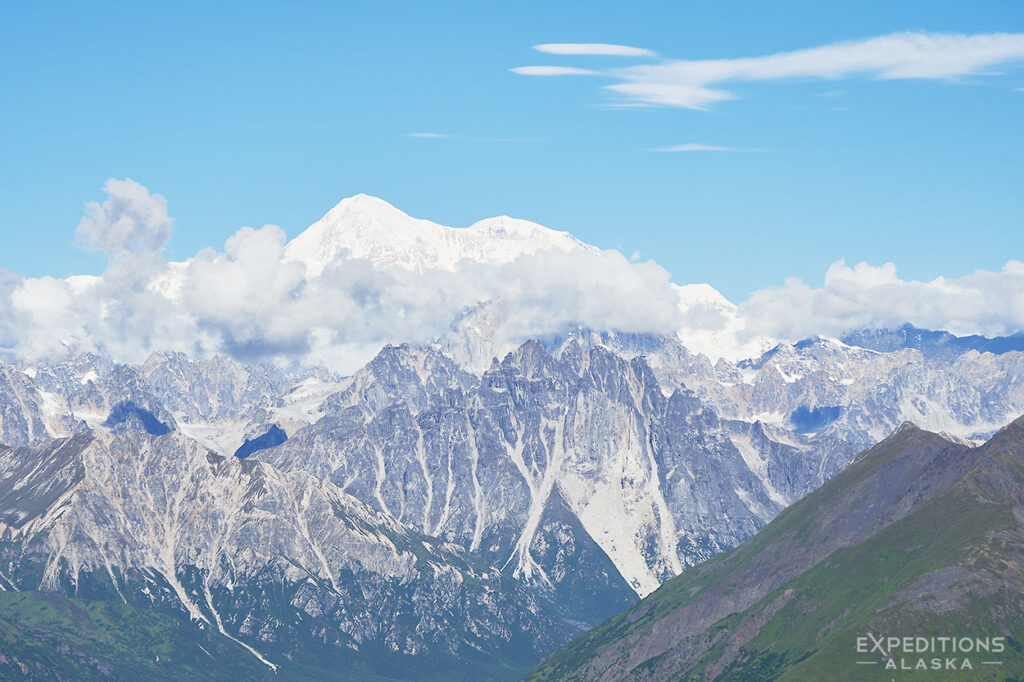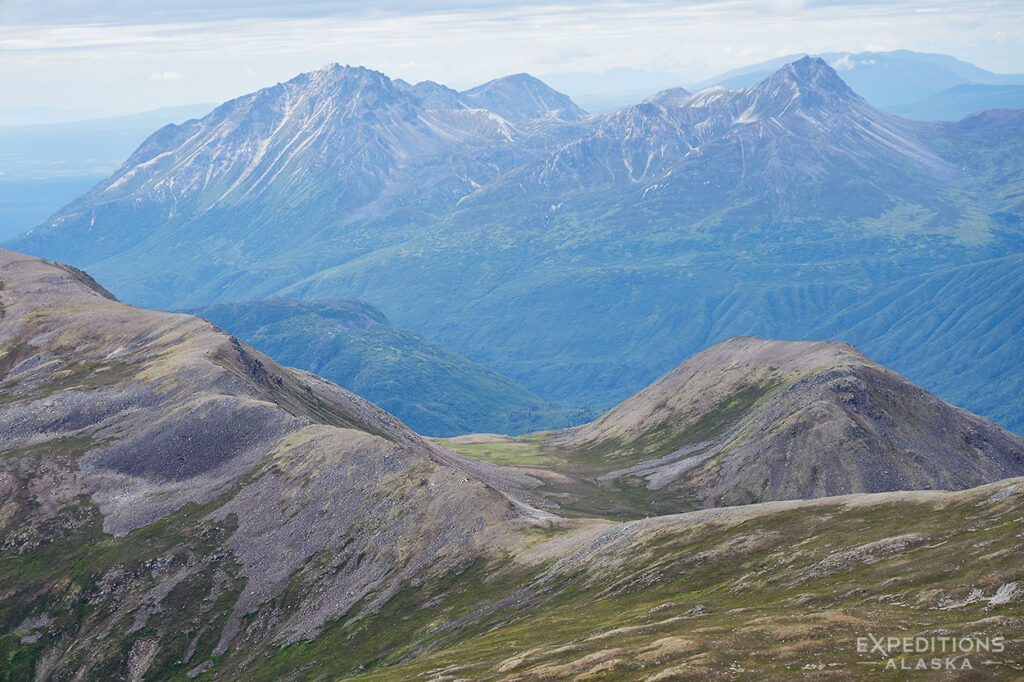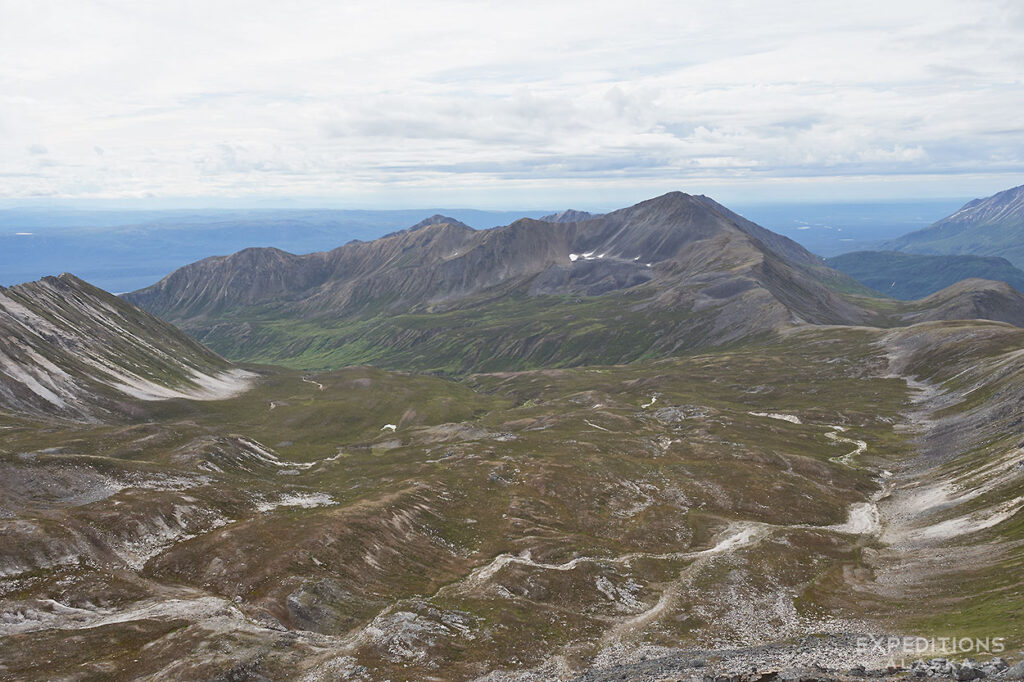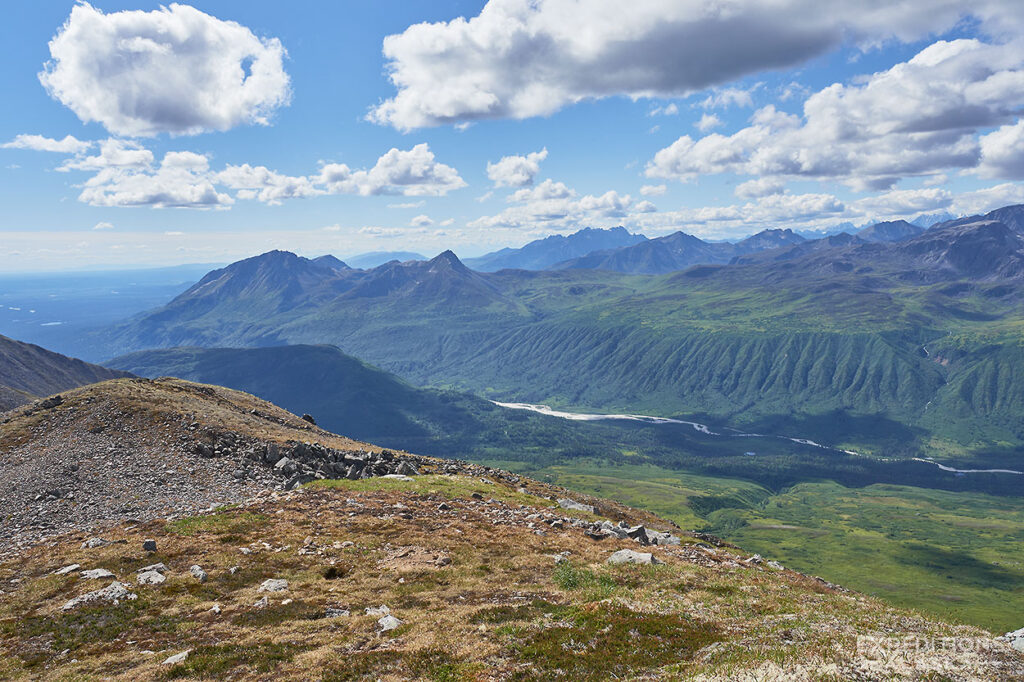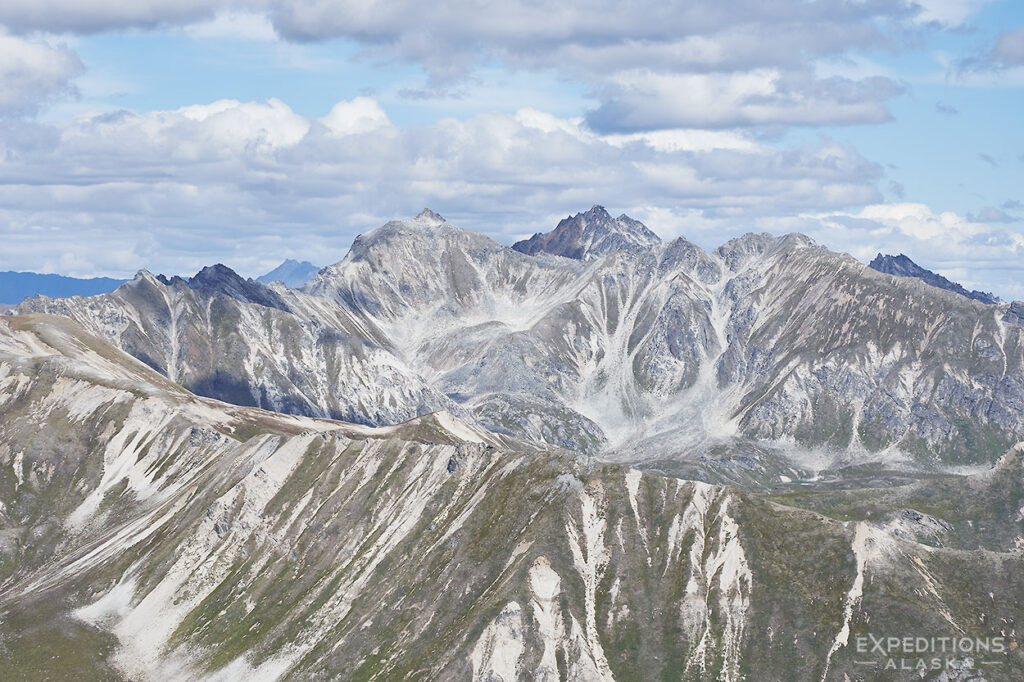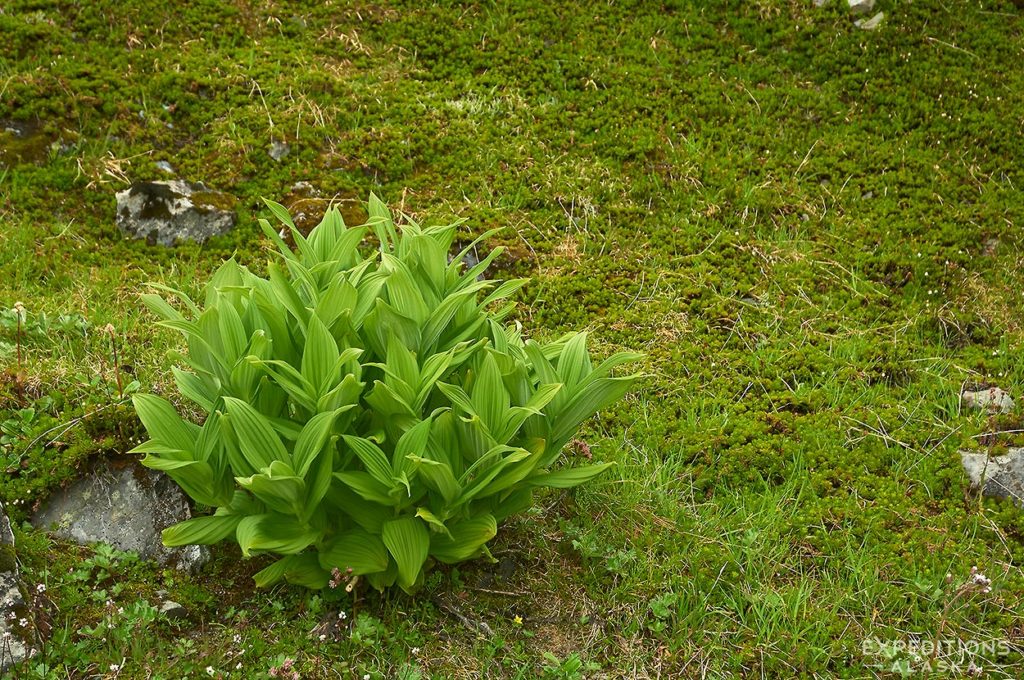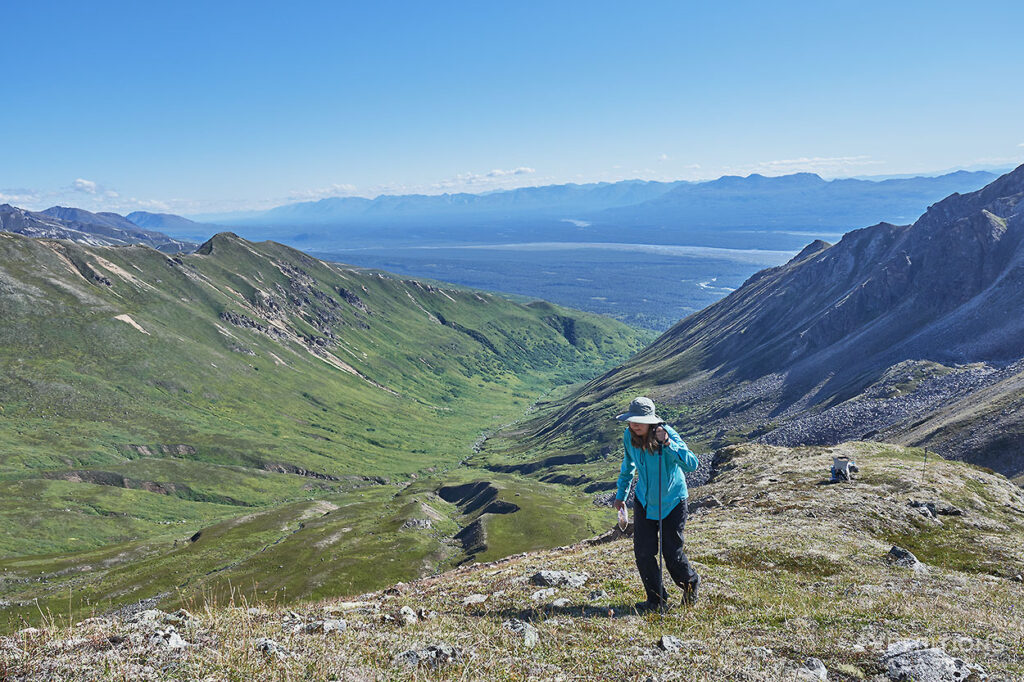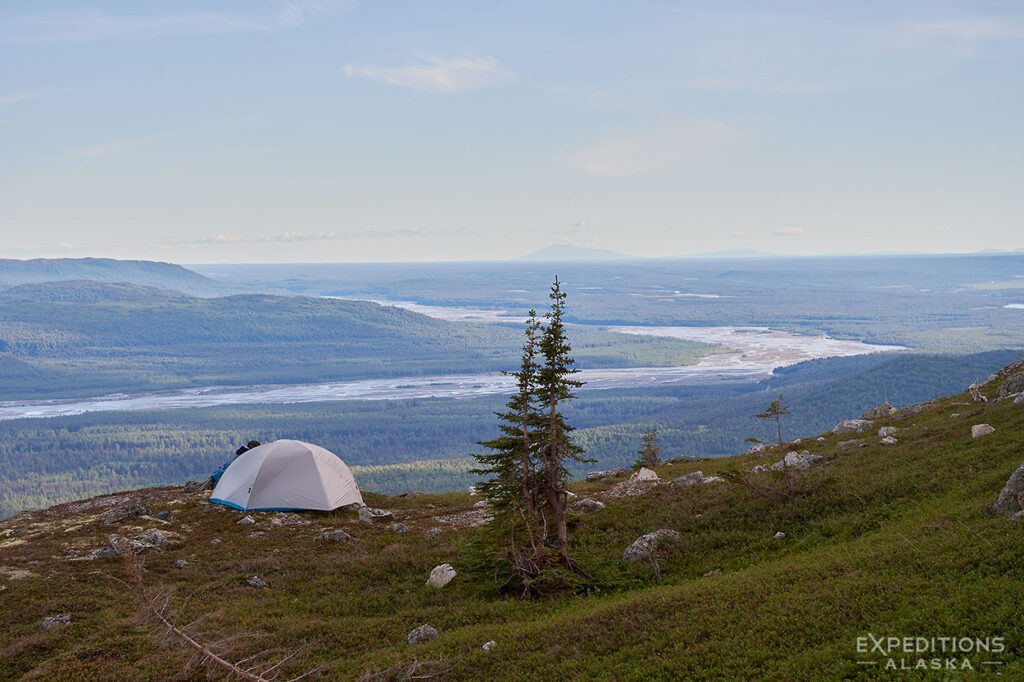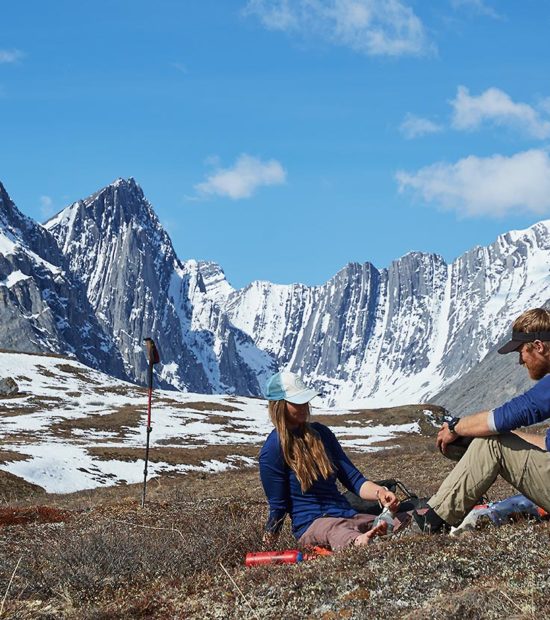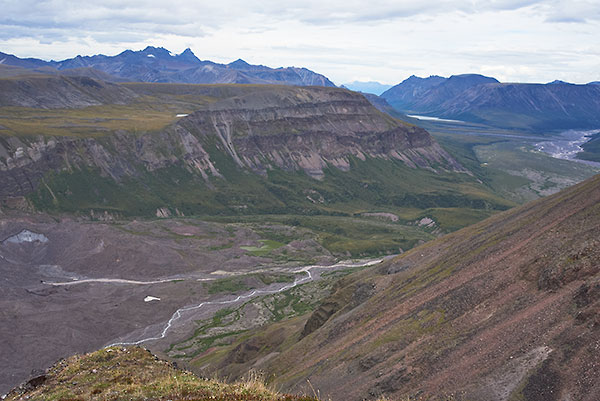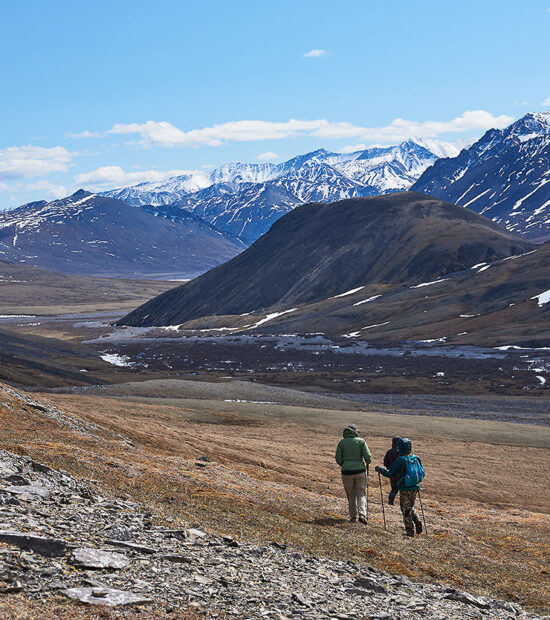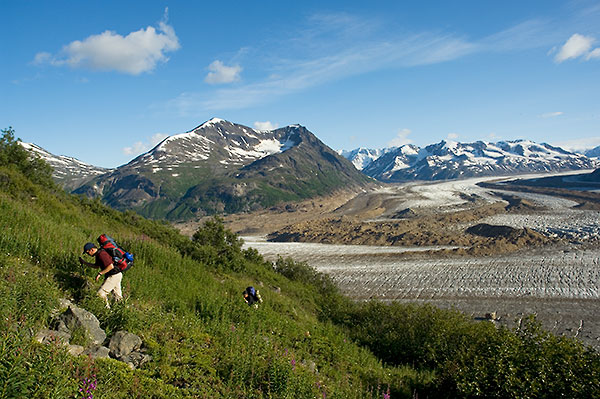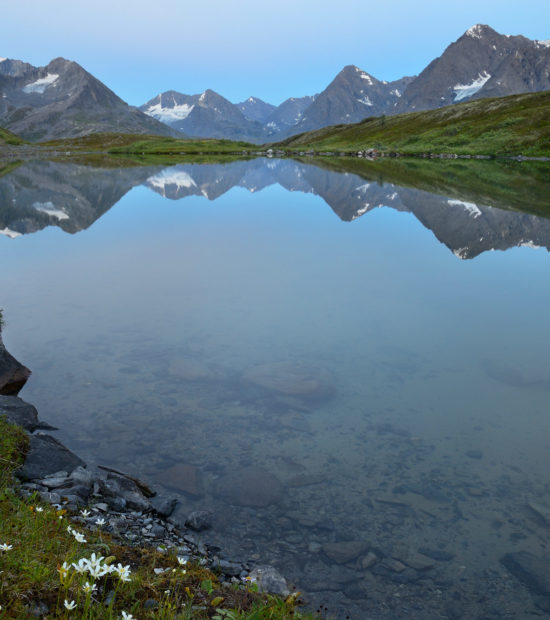Trip Details
The backpacking is endless in this area. You’ll explore the high country, traversing ridges and walking up valleys. The hidden gems of the area are right outside your tent.
From our drop-off point, we hike to camp. It’s a steep little sidehill, and a solid hit out to get you started.
Thereafter, it’s gold.
The walking here is a mix of everything. Tundra, scree, brush, plateaus, creeks and moraine. If diversity is a strength (and we think it is), this Denali backpacking trip is one of the strongest yet.
We’ll backpack and explore the area bit. Rhane checked it out recently and came back eyes wide open and mouth agape, “Carl, you gotta get in here”. So here we are.
It’s a good fit for folks who can backpack, are comfortable on different types of terrain and bring a flexible mindset on what a trip like this looks like. If you’re a “on day 1, at 3pm, what do we do?” kinda person this one might not be for you. Yet.
If you’re an adventurer, a backcountry-capable and fit, durable kinda person, who wants to explore an extremely rarely visited area in this most famous of National Parks, tag us.
We’d love to bring you along.
Logistics
We’ll meet you in Talkeetna, a tiny town with a giant personality, and the gateway to all things Denali. We’ll fly from Talkeetna to our drop-off point in the park. After the trip, we’ll return to Talkeetna for one night.
We strongly recommend that you schedule your departure flight from Anchorage for the following night after 8pm or, safer, a day later. Alaska’s weather likes to upend itineraries. So, in case we need to spend an extra night in the backcountry until our air taxi can pick us up, it’s best to build in an extra day in Alaska from the get-go.
Trip insurance is required.
Is This a Fit For You?
Who’s it For?
Adventurous experienced backpackers. Intermediate level, with advanced option.
Confident, durable and fit people.
Any wilderness backpacking trip can throw a curve, even those we’ve hiked for more than two decades. Trips we’ve seen less of can be even more challenging to navigate. Newer backpacking trips tend to have more variables we haven’t yet dealt with. We want to be comfortable with changing plans and conditions.
Not everyone can do that. Fewer people still can do it well.
Challenges
Weather is always a challenge in the Alaska Range, and particularly up above treeline. Be ready for everything Denali can throw at you. Wind and rain, more rain, snow, sleet, fog, more wind and rain, and (fingers crossed) some gorgeous blue skies.
Terrain is everything. You need to be confident in your balance, comfortable with a heavy load on your back. Be able to navigate varying and steeper hillsides. The Alaska Range don’t play.
Sidehilling is your biggest challenge here. So be good on your feet.
How'd we find this spot?
With a of patience and scouting and exploratory diligence.
It takes time to really get into the weeds using satellite imagery, a boatload of topo maps and way too many hours of close scrutiny of terrain and topography and the lay of the land.
Then we sent 3 different guides into the park to find what goes and what doesn’t.
This one goes.
Let's Talk Difficulty Ratings
How difficult is it?
It’s this difficult. ->
LOL 😀 😀 😀
This is Rhane’s mom, on our scouting trip. She crushed it, but really enjoyed this rock for a break spot.
A good rock needs to be sat upon.
Denali & Wildlife
Denali National Park & Preserve is home to some of the best wildlife viewing in the nation, but this particular area we travel is the high country. It’s more rock and ice and tundra than lush rich wildlife habitat.
Denali National Park is a stunning hiking trip and you’re never quite sure what you might see.
That said, bears live here, so black and brown bears are present, as can be wolves and even moose and Dall sheep. Caribou don’t tend to be in this area. Foxes and other small animals are often seen here too.
Sidehilling doesn't sound too bad
Sidehilling doesn’t quite “sound” like what it is.
When I say “bushwhacking” or “river crossing”, people seem to have a good sense of what that feels like. Sidehilling is a bit deceptive. it’s more challenging than it sounds. And it’s more challenging than you think it is.
Fortunately, we don’t have too much. Maybe a mile or so.
Backpacking and Basecamping
We’ll have a couple of versions of this trip.
A Denali Backpacking trip that works for those who really wanna get after it. We’re offering both 7 and 10 day backpacking trips for you folks who want to boot up and get walking. You’ll want to be a solid backcountry backpacker.
We can adjust these and tweak the itineraries if needed. So if you want something a little longer, or maybe a little shorter, give us a holler.
We’ll also have a basepack trip, 5 days, for those who want to fly in, backpack a short walk to camp, make a great campsite and explore the countryside. If this is you, let me know.
BACKPACK OR BASEPACK
An Adventurer’s Backpack
A backpacking loop brings us back to our landing spot. There are options to do this over 10 days, or cut it shorter and just do 7.
The 10 day trip is a bit gnarlier. Be on top of your game for this one. We have a couple of high, rugged passes to traverse. Don’t be intimidated. But be comfortable on mountain terrain.
This longer one is going to be a bit exploratory in 2023. It’ll work well for those hardy, experienced, fit backpackers who really like to explore something new. If this is you, reach out to us.
7 Day Backpack
The 7 day is a good intermediate version, for those who can walk and carry their gear through most terrain.
Most of the hike is pretty good walking, with little adversity beyond the normal challenges (carrying 40 pounds on your back is hard)! We have plenty of time.
This trip will work well for most folks who can backpack. This is for those people with no backpacking experience.
Basepack
The Basepack is for non-backpackers.
You’ll have to backpack a few miles from our landing strip to a campsite. And it’s a challenging hike. Steep sidehilling. Then we set up camp and walk and hike and camp and eat and sleep and watch the mountain all day long. Then we return the way we came to meet our pilot.
The first 3/4 mile or so is hard. So don’t think “oh this one looks like me, it’ll be easy”. This is a good choice for those folks who CAN backpack, but want to avoid the hassle and physical stresses of moving camp every day.
Itinerary
This trip is a new one for us, so we’re approaching it in 2023 with a “keep on your toes” mindset. We scouted it in 2022 and are sure this trip is set to be a firm crowd favorite.
We’ll plan on meeting you in Talkeetna, Alaska.
Why Talkeetna? Because it’s one of the hippest little towns in all of Alaska. That’s why.
From there we gear check and review, and then fly in to the most famous National Park in all of Alaska, and one of the most famous parks in the world.
FAQs
-
How do we get to Talkeetna?
There are a few options. A number of shuttles run daily Anchorage – Talkeetna, and that’s probably your best bet, saving a rental vehicle, etc. you don’t really need a car in Talkeetna, but if you want to spend the cash, and can get a vehicle, it does make life a little easier and more flexible.
Shuttle Service through Alaska Shuttle.
Denali Overland is a great choice with daily runs between Anchorage and Talkeetna as well.
You can also take the train from Anchorage to talkeetna, which might be a fun adventure. More info is available here.
-
Is there any fishing here?
No. None.
-
How Much Experience Do I Need?
Some.
It’s hard to say precisely, but if you’ve not backpacked before, it might be a good idea to go try it before flying into one of the largest and wildest national parks in the country and walking around with no trails.
That said, we have definitely had plenty of folks with no experience do just fine on even challenging trips, so it’s a very subjective thing
-
Do we include Lodging in Talkeetna?
Yes we do. It varies, but we usually include the final night of the trip. Some years/trips it might be the first night, we’ll let you know as we make those arrangements.
-
How are the difficulty ratings defined?
Well, “defined” probably isn’t the right word. This is Alaska after all. But this an important question to consider.
One boot equals easiest and five boots the most challenging option. Thanks.
As a general rule I’d suggest rating everything here one notch from what you might be used to (assuming you haven’t hiked in Alaska before). If you consider yourself up for an intermediate level hike assume that a trip rated intermediate here will probably be a bit tougher than you’re expecting. Not impossible, but harder than you think.
As I mentioned above, terrain is the biggest factor here and it’s extremely subjective as to what is difficult terrain and what is not.
Some people really struggle walking over a boulder field, and others don’t find it difficult at all. Some people find sidehilling more difficult, or bushwhacking, and so on. Well, everybody finds sidehilling difficult. But the most common element people struggle with is almost always terrain. Your balance is probably a more important consideration than how miles you run on a treadmill each day in the gym.
One of the best ways to lower a rating is simply give yourself an extra day or 2. Make a 5 day hike a 7 day hike and it’ll much more manageable. Conversely, if you want a challenge give yourself a little less time and you’ll find just about any trip here as challenging as you could want it to be.
Again: please carefully . It’s the boot icon in the sidebar of the trip page.
Thanks.
-
What gear do I need?
You’ll receive a Trip Departure Packet upon your reservation with a detailed Gear section and a comprehensive Gear Check List for you. Read it carefully and be sure you have the appropriate gear with you. We’ll do a gear review before your trip but you really should contact me with any questions you have before you arrive in AK.
You’ll find tons of information on gear and related stuff on the blog. You’ll find some extensive commentary there about gear and backpacking and hiking trips, etc. Rain gear and keeping dry, down versus synthetic sleeping bags , backpacks, and so forth. I update it reasonably often, so do check out the blog posts for information. Here is a link to The Gear Category on the blog.
In the meantime this should help you get started below.
Bring a sturdy backpacking tent. Lesser ‘car camping’ tents can fail miserably when you need them the most. If you don’t have a tent, or aren’t certain, please inquire with Expeditions Alaska. We’ll rent you a tent if you prefer.
Good rain gear is a must. I recommend a lightweight, gore-tex type shell. A poncho-style rain jacket or shawl is NOT recommended (as in, DO NOT BRING ONE).
A sleeping bag that will keep you warm down to 20deg (F) is what I suggest (or lower). A 32deg (F) bag would be considered bare minimum for most Alaskan summer adventures and I do NOT recommend it. Either synthetic fill bags or down bags are great – you just need to keep them dry. Read more about your sleeping bag here.
Unless you’re booking a fully outfitted trip you’ll need to bring a reliable stove. Bring a reliable stove, preferably one that burns white gas, or Coleman fuel. MSR ‘Whisperlite‘ or similar stoves are great. Remember that with current restrictions on air travel it is illegal to bring fuel onto commercial planes. I can provide fuel for you, available when you arrive in Alaska.
Another stove that’s very popular recently is the Jetboil.
My preference is for long sleeve shirts and full length brushed nylon pants. A mosquito headnet is also recommended for those times when the bugs get gnarly.
Do bring cotton pants, shirt, socks, etc. If you’re confused about this, contact me.
Trekking poles are worth their weight in gold. Don’t head for Alaska without them. Expeditions Alaskan provide these (free) if you like.
Definitely bring sturdy, waterproof boots. Your lightweight day hikers may be fine around town but they are often not durable enough to withstand a multi-day alpine adventure. Alaska Hiking boots info.
A comfortable backpack is required and a system for carrying gear on a dayhike is very handy. Many backpacks have removable tops and these work great. A rain cover that fits your fully loaded pack is a must have!
Another choice for is a small summit pack for dayhikes. I use the Marmot Kompressor. Not requisite but handy to have.
The single most important element of gear is your ability to use it.
Practice with your equipment before heading into the backcountry. Do not wait until you’re miles into the wilderness before you realize your stove doesn’t work or that you don’t know how to set up your tent. Being comfortable with your equipment and how to use it can be paramount to a safe and enjoyable trip.
-
Do you have a Gear Check List?
Oh yeah. Right here
Upon your reservation I’ll also send out a detailed Trip Information Packet with more than enough information on gear to keep you busy. Until then the above check list is a good outline of what you need.
-
Tell me about this “off trail” backpacking?
Typically, it doesn’t mean we go “off the trail“. It means there is trail. These are two very different things.
Offtrail hiking, or no trail hiking, is hard at times, easy at others, and very hard at others. It’s almost always changing, and not something you should dismiss as irrelevant. In fact, it’s probably the single most important thing to understand about our backpacking trips.
I’ll say that again. Louder.
When we say offtrail backpacking we’re talking about traversing boulder fields, hiking through dense brush, over steep scree and talus slopes and walking for hours on steep grassy mountainsides. All of which are harder than you think they are.
Trust me.
I’ll keep this post brief, but you can read a lot more about this subject (and I recommend that you do) on this blog post.
It’s important.
-
What comes with the Food Add-on?
If you’d like, Expeditions Alaska can handle your backcountry food for the trip. Cost depends on trip length, but it’s typically $325 for a 2-4 day trip, and $425 for a trip 5 days or longer (backcountry days).
We will organize and pack the food, handle all backcountry prep, as well as pots and pans, the stove/s, fuel and your mess kit. Assistance for cleanup and dishes is always appreciated, but not requisite.
NB: this means, if we’re doing food for your trip, you must arrive with requisite space in your backpack for your share of the food. This typically means a BV500, sized 8.7 in. diameter. (22.1cm) x 12.7 in. (32.3cm) height. There’ll also be your mess kit (cup, bowl, cutlery, etc) and maybe some additional group gear, whether it’s a fuel bottle, stove or pan or skillet. In general your guide will carry the bulk of this stuff, but we certainly can’t and don’t intend to carry all of it. So don’t arrive with a backpack packed full, no space left in it, if we’re doing your food for you. Your food goes in your pack.
More info linked on the page below.
All your questions about our backcountry food answered right here.
-
How should I structure my travel arrangements?
Travel Suggestions
- Do NOT book your commercial flight early the next morning. The later the better. Better still, the day after that,
- Book a refundable/changeable ticket for your return flight home, and
- Purchase travel insurance.
Weather delays are always possible in the backcountry with bush planes.The more cushion you give yourself before a committed departure flight home, the better.Definitely don’t try to book something out on the evening of our return. Or the next morning. We SHOULD be back by then, but there are so many moving pieces to these trips, it’s much better to not have the stress of having to re-arrange flight schedules. Even if it’s just for something simple like road construction delays or flat tires, or a healthy travel schedule is one with some slack built into it. -
Itinerary caveats
I put trip itineraries online here to give visitors a more detailed look at some of our trips and what options they include.
I can’t over-emphasize that each is simply an example.
What I work hardest on is tailoring trips to the specific interests and abilities and experience of the people who hike with us. No 2 trips are the same. Where possible we don’t use the same campsites when we do a route and we often even vary the route when appropriate to do so.
I try to be flexible with how far we hike each day and how many days we spend in the backcountry. What time we get up in the morning, for example, is largely up to the trip participants (unless for some reason I feel we need to be up and on the trail by a particular time – this rarely happens).
Itineraries are somewhat fluid. As they should be. Weather, hiker experience and many other factors determine the actual trip.
So don’t expect the itinerary for a trip to match an outline of Day 1 we hike abc, Day 2 we hike xyz, etc, etc. It doesn’t (and in my opinion shouldn’t) work that way. The itineraries listed on this site are
a) to outline the travel time and logistics for you, and
b) attempt to help give you some sense of the route and how it goes.
But with wilderness trail-less backpacking routes, these kinds of structured itineraries are really not very useful.
-
What’s Included/Not Included?
All trips and trip prices include the following.
* Professional Guide Service: Experience is paramount, as is a friendly, flexible atmosphere for your trip, and Expeditions Alaska, LLC go out of our way to bring that to the backcountry. I know the routes, the natural history and the place as well as anyone, and all the best campsites! Backcountry camping in Alaska can be intimidating for a novice and even for some intermediate and experienced hikers. A qualified guide service can go a long way to minimizing problems that may come up. Customers returning for
seveneightnineten consecutive hiking trips with Expeditions Alaska speaks volumes for the value of a good guide.* Travel and Accommodations: Expeditions Alaska, LLC typically offers a complete .
For example, for our Wrangell-St. Elias National Park trips, we’ll pick you up from your hotel in Anchorage, drive to McCarthy in our comfortable conversion van, stay the night at the Kennecott River Lodge, enjoy a hot breakfast the following morning in McCarthy, then fly into the backcountry. Backpack and hike for your trip, fly back to McCarthy, have the afternoon in and around McCarthy, exploring the Kennecott Glacier, or the old mines up at Kennecott, spend another night at the Kennecott River Lodge, and drive back to Anchorage the final day, right to your hotel in Anchorage.
For the ANWR trips, we’ll usually travel from Fairbanks to Coldfoot or Kaktovik by plane, then fly into the backcountry. Whether we pick you up at your hotel in Fairbanks or not will depend on whether we’re driving or flying north. If we fly, we’ll meet you at the airport. If we’re driving, we’ll pick you up.
.
* Gear: We can provide all cookware, fuel, etc for the trip. Feel free to let us know if you’d like to bring your own. We can get the fuel you need as it’s not possible for you to fly with any fuel in your luggage. If you would prefer a fully outfitted trip we can accommodate that. You’ll need to bring your personal gear, such as a sleeping bag and backpack. We’ll also provide bear-resistant food canisters and bear spray for the trip. Expeditions Alaska, LLC trips will also provide a cook tent for the trip. We also provide hiking poles for you if you don’t have your own.
* Safety: Any professional guide service puts safety first. This means caution, it means responsibility and it means an excellent knowledge of the area: the terrain, wildlife and travel, backcountry camping and safety. Fully qualified Wilderness First Aid certification. A satellite phone available for emergency backcountry service if necessary and a backup emergency messaging device such as Delorme inReach or PLB. We bring a GPS, map and compass on every route we do. This is an owner-operated business and all participants can feel confident knowing they’re not getting an intern or inexperienced guide for their trip.
* Storage: Extra travel items that won’t be needed while we’re in the backcountry (limited space available).
What’s Not Included?
Expeditions Alaska, LLC do not provide the following unless otherwise specified.
a) food and camping gear — Expeditions Alaska will outfit your trip if you would like us to. For a minimal addition in cost, I’m glad to supply food and camping gear (you will need your own personal gear, such as a sleeping bag, pad, clothes, pack, etc). Any specific items you may need help with, just send me an email or call me and I’ll work it out for you.
b) travel arrangements to Anchorage from outside Alaska.
c) trip insurance. Our suggestion is Travelex.
d) travel meals. Any hotel or lodge meals we eat in the frontcountry are not included in your price. So if we stop to eat along the road, for example, we do not pick up the tab for that.
d) guide gratuities.
Extra Info
The ANWR and Gates of the Arctic National Park trips include all travel (return) from Fairbanks to Coldfoot, or from Fairbanks to Kaktovik, where we fly into the Refuge, as well as rafts, dry bags, etc. The Icy Bay and Malaspina Glacier trips start and end in Yakutat, Alaska. Because of the nature of backcountry adventure, trips vary year to year. Each trip is also available for longer or shorter durations, and trip prices vary accordingly. Similarly, group bookings (3 or more participants) can receive substantial discounts.
For more information, contact us using the Contact Form here.
All clients complete the backcountry waiver before departing for any of our trips.
-
Cancellation policy
Reserving your place on a trip requires a 50% deposit. Deposits are non-refundable. All trips be paid in full 45 days prior to the scheduled departure date.
If the client cancels on a trip paid in full, 80% of the price can be deferred and applied to another trip that is scheduled to occur within the next 12 months, provided that all three of the following occurs:
i) Expeditions Alaska, LLC is able to fill the cancelled spot,
ii) Expeditions Alaska LLC is able to fill the the trip that the client cancelled on, and
iii) 30 days (or more) notice is given.If a client cancels a trip and Expeditions Alaska is not able to completely fill that trip, regardless of the number of original participants in that trip, Expeditions Alaska will not defer or refund any portion of the cancelling client’s payment.
Expeditions Alaska, LLC cannot guarantee that a spot will be available on a scheduled trip in the next 12 months. If no spot is available and you cannot use your deposit in those 12 months, the deposit is forfeited and non-refundable.
If cancellation is within 30 days of the trip, only 50% of the fee can be carried over to a future trip. The remainder is forfeited and non-refundable.
No refunds, credit, or other reimbursements are given for cancellations within 14 days of the trip departure.
Expeditions Alaska, LLC reserves the right to cancel and/or modify the itinerary of a trip for any reason. If Expeditions Alaska cancels a trip you will be refunded your payment in full, minus a $250 administrative fees plus any unrecoverable deposits Expeditions Alaska, LLC made to organize the trip. If Expeditions Alaska cancels changes the date of a trip and you can no longer attend, you will be refunded your payment, minus a $250 administrative fees plus any unrecoverable deposits Expeditions Alaska, LLC made to organize the trip.
If weather or other factors delay or impede your trip, there will be no refund of fees. Expeditions Alaska, LLC is not responsible for any other costs incurred by the client as a result of the cancellation, delay, or modification of a trip.
Additional costs incurred through weather delays and itinerary changes are the responsibility of the client.
Additional costs incurred by the client, such as changes to flights or additional costs, etc, are the sole responsibility of the client.
-
Why are there so many questions?
 Just kidding – it’s really not meant to intimidate anyone. It’s a difficult thing to choose a trip like this, often with relatively little real understanding of how different backpacking here in Alaska is, different even from the more rugged and “wild” parks in the Lower 48 states. Most folks that come up here are not used to backpacking off trail (or, rather, “no trail”), and that really makes a big difference. Your gear choices, your choice of trip, the time you allow for it, and so on, become more critical choices when you’re in a place like this. This page is intended to try help you sort through this and help figure out what kind of trip will work best for you.
Just kidding – it’s really not meant to intimidate anyone. It’s a difficult thing to choose a trip like this, often with relatively little real understanding of how different backpacking here in Alaska is, different even from the more rugged and “wild” parks in the Lower 48 states. Most folks that come up here are not used to backpacking off trail (or, rather, “no trail”), and that really makes a big difference. Your gear choices, your choice of trip, the time you allow for it, and so on, become more critical choices when you’re in a place like this. This page is intended to try help you sort through this and help figure out what kind of trip will work best for you.At the same time, the rewards and the thrill of a place like this are also unique. I’ve no question at all that if you’ve read this far, you’ll love your Alaska backpacking trip, whether it’s with me, or another guiding service, or a trip you take on your own. Just be careful out there.
Happy Trails!
-
I still have more questions
We all do. Questions are good. That’s how we learn. Either give me a call or send me an email and we’ll go through them.
I also send out a comprehensive Trip Information Packet upon your reservation and that will usually answer your questions.
Cheers.

